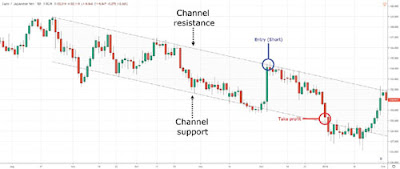Why do we exit our position in forex?
“Exiting a trade” means closing your position. You can close out a losing position or take a gain when exiting a winning position.
Here's some secret strategies to follow whenever we will exit our position:
TRADE EXITS: HOW TO CAPTURE A SWING
A swing refers to “one move” in the markets. The
idea of capturing a swing (also known as swing
trading) is to exit your winners before opposing
pressure comes in. Here’s an example:
The advantage of capturing a swing is that you
endure “less pain” because you exit your trade
before the market reverses against you. This improves your consistency and your winning rate.
But the downside is that you’ll miss big moves in the
market as you exit your trades too early.
So if this approach is for you, then the key thing is
to exit your trades before opposing pressure steps
in. This means if you’re long, you’ll want to exit your
trade before selling pressure comes in. And where
would that be? Possibly at swing lows, support, the
lower channel, etc.
Here’s an example:
The only way you’ll ever ride a trend is to use a
trailing stop loss. This means you progressively shift
your stop loss higher as the market moves in your
favor. Here’s what I mean:
The beauty of riding a trend is that you can reap
massive profits doing little to no work. You can
expect your average gains to be two-to-three times
larger than your losses. But, there’s always a but,
right? The downside is that you’ll only win 30%-45%
of the time, you could give back 30%-50% of your
open profits, and it’s common to have your winners
turn to losers.
Psychologically, riding a trend is one of the most
difficult things for traders to do. But if this approach
is for you, the key is to embrace your losses and
adopt a proper trailing stop-loss technique. So how
do you trail your stop loss? There are many ways to
do this, like moving average, average true range,
market structure, etc.
TRADE EXITS: MOVING AVARAGE
Let me give you an example using moving average.
If you want to ride a long-term uptrend, you can
trail your stop loss with the 200-day moving
average. This means you’ll only exit the trade if the
price closes below the 200-day moving average;
otherwise, you hold onto it (and it’s just the opposite
for a downtrend). Here’s an example:
In addition, you can tweak the moving average
to accommodate the type of trend you want to
capture. If you want to ride a medium-term trend,
you can trail your stop loss with the 100-day moving average. Or, if you want to ride a longer term trend,
you can use the 300-day moving average.
TRADE EXITS: MARKET STRUCTURE
Another way to trail your stop loss is by using market
structure. As you know, an uptrend consists of
higher highs and lows. So what you do is trail your
stop loss using the previous swing low. This means
if the price closes below the previous swing low (by
more than one 1 ATR), you’ll exit the trade (and vice
versa for a downtrend). Here’s what I mean:
Unlike moving average, market structure is
subjective because it requires discretion when
you’re identifying the swing highs/lows. So if you
prefer something more objective, use moving
average to trail your stop loss.
TRADE EXITS: HYBRID APPROACH
Finally, you can combine both approaches to
capture a swing and ride a trend. Here’s how it
works. Let’s say you’re in a long position and the
market has come into an area of resistance. You’re
not sure if the price could break out higher or not.
So what now? Do you take all your profits and just
capture a swing? And what if the price breaks out
higher and you miss a good chunk of the move?
Well, what you can do is sell some of your position at
resistance and hold the remaining portion to see if
the price breaks out higher. If it does, you’ll have the
potential to ride the trend higher. If the price doesn’t
break out higher but reverses instead, then you’ll get
stopped out on the remaining position. But at least
your earlier position closed at a profit (and this will
subsidize some of your losses).
Now, if you want to adopt this approach, my
suggestion is to exit no more than 50% of your
position for the first target because if you exit with
anything more than that, the remaining position
won’t make much of a difference to your bottom
line.
For example, if you exit 90% of your position at
resistance and hold onto the remaining 10%, even
if your remaining position gives you a 1:10 risk-to-reward ratio, the net profit is only a gain of 1R (since
it’s 10% of your original position size).
What about the downsides? Well, there are two:
1. If the market trends well, you’ll never have your
full position size on because a portion of it was
exited earlier. 2. If the price hits your first target
and reverses, you might end up at breakeven or
experience a small loss. But had you chosen a swing
trading approach, that trade would have been a
winner.
By now you should realize that there’s no best
method, strategy, technique, or whatever in trading.
There are always pros and cons with any action you
choose. So the key isn’t finding the holy grail but
finding a method you can embrace and execute
consistently.






